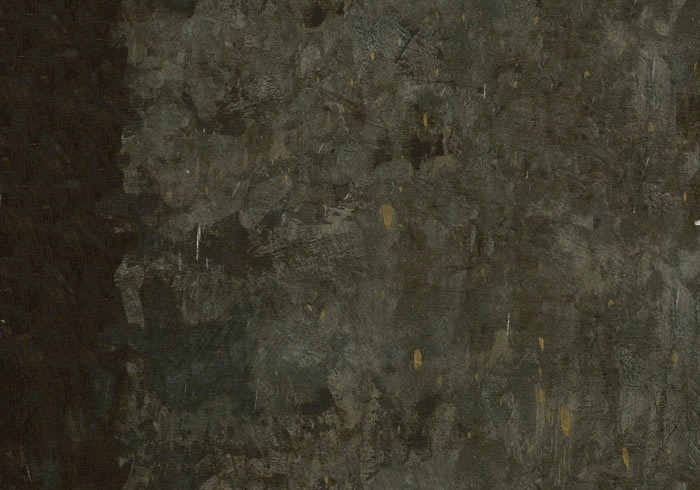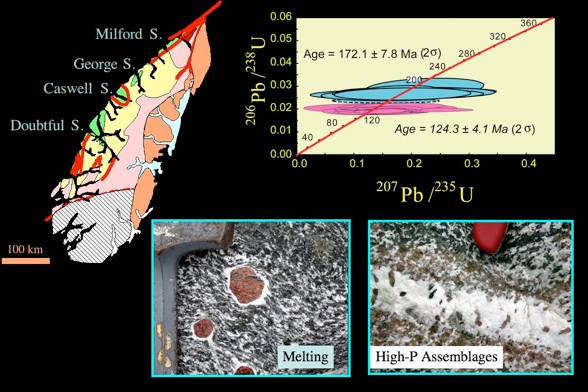LEFT: showing a simplified geologic map of Fiordland (yellow – Early Cretaceous batholith composed of granulite facies orthogneiss, green – Paleozoic host rock of the Gondwana margin, pink – undifferentiated arc rocks of Paleozoic and Mesozoic age, brown – magmatic rocks of the outboard arc, red – shear zones). UPPER RIGHT: Concordia diagram showing U/Pb data on zircon and the ages of the inboard and outboard suites of Cretaceous igneous rock. LOWER LEFT: Lower crustal migmatite of ~120 Ma age. LOWER RIGHT: High-pressure (14 kbar) granulite facies mineral assemblages (garnet, clinopyroxene). Both melting and metamorphism accompanied batholith emplacement at ~120 Ma.



Deformation and Magma Transport
We used structural observations and U-Pb geochronology on zircon from Fiordland, New Zealand to develop a model of partitioned transpression within the lower crust of an Early Mesozoic magmatic arc exposed in Fiordland and to test whether transpression was an efficient mechanism for transporting magma through the deep lithosphere. A continentward migration of magmatic activity occurred within the margin of Gondwana after ~140 Ma followed by a period of concentrated magmatism in a vertical, 12-15 km wide lower crustal shear zone after ~119 Ma. The shear zone, named the Indecision Creek Shear Zone, contains variably oriented dioritic intrusions and displays systematic variations in the three-dimensional orientation of ductile structures. Structural patterns indicate that arc-parallel sinistral oblique-slip and strike-slip displacements occurred at the shear zone margins and that deformation in its center was dominated by horizontal arc-normal shortening and near vertical extrusion. This style of partitioned transpression reflects the effects of rheological contrasts created by a heterogeneous pattern of magmatism within the arc. Field relationships and U-Pb dates on zircon suggest that the shear zone formed along the boundary between outboard (older) and inboard (younger) parts of the batholith and facilitated the transfer of small volumes of magma vertically through the lower crust until at least ~111 Ma, when convergence and arc magmatism waned.
Selected References
Marcotte, S.B., Klepeis, K.A., Clarke, G.L., Gehrels, G. & Hollis, J.A., 2005, Intra-arc transpression in the lower crust and its relationship to magmatism in a Mesozoic magmatic arc. Tectonophysics, 407, 135-163.
Klepeis, K.A., G. L. Clarke, G. Gehrels, J. Vervoort, 2004, Processes controlling vertical coupling and decoupling between the upper and lower crust of orogens: results from Fiordland, New Zealand, J. of Structural Geology, 26(4), 765-791.
Klepeis, K.A. & Clarke, G.L., 2004, Evolution of an exposed lower crustal attachment zone in Fiordland, New Zealand, In: Vertical coupling and decoupling in the lithosphere, Grocott, J., McCaffrey, K., Taylor, G., Tikoff, B. (eds), Geological Society, London, Special Pubs., 227, 197-229.
Klepeis, K.A, Clarke, G.L., Rushmer, T., 2003, Magma transport and coupling between deformation and magmatism in the continental lithosphere, GSA Today, 13(1), 4-11.
King, D.S., Klepeis, K.A., Goldstein, A., Gehrels, G., Clarke, G.L., 2008, The initiation and evolution of the transpressional Straight River Shear Zone, central Fiordland, New Zealand. J. of Structural Geology, 30, 410-30.


Tectonic model for the evolution of the Median Batholith during the Mesozoic (after Marcotte et al., 2005).